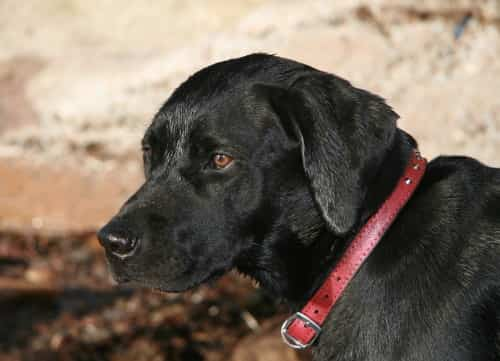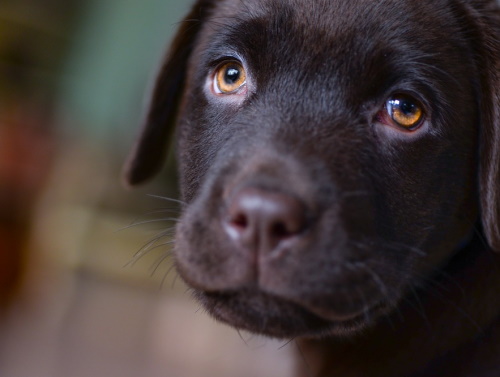The Versatile Labrador Retriever
The Labrador Retriever has so many good qualities it is hard to name
them all. Owners have described their Labs as playful, affectionate,
friendly, lovable, clownish, loyal and intelligent. Wow!

Training a Labrador puppy is a very important responsibility when it comes to owning a Lab, because when full grown
they are a big, strong dog that can be quite a handful without proper obedience training.
On the other hand, Labs love to please and are easy to train, but the caveat is not to get
into training too early as the Lab is a late maturer and you will be frustrated if you start too soon.
The fact that the Labrador Retriever has been trained so successfully to assist the handicapped, in rescue, and as a sniffer dog, proves his trainability.
But, because the young Lab has a rambunctious personality and likes to turn everything into a game, training needs to be reward-based, low key, while at the same time firm and consistent.
And, be sure to get the entire family to reinforce the training - remember consistency pays off!
It is important also to note that this is a dog with a long puppy-hood, up to 2 years, which means he needs a patient owner who is willing to work through the rough spots to get to the "poster" dog that lies ahead.
If owners can do this, they will be rewarded by having one of the best dogs around. The consensus among Labrador owners is that Labs are absolutely great!

Origins of the Labrador Retriever
The Labrador Retriever originated on the island of Newfoundland. Early stock for the Lab came from a breed known as the St.
John's Water Dog, a dog which resulted from the breeding of various water dogs with the Newfoundland breed.
Eventually, the
Labrador was brought to England and subsequently a standard was defined for the breed. Accurate records for the breed as we
know it today, date back to 1878.
Characteristics
The Lab is an alert dog of medium size, very athletic and well-balanced in appearance. He was originally bred to be a retriever of game, both over land and in water.
His intelligent focus, strong body, powerful jaws, weather resistant coat and webbed feet, provide it with the physical attributes to do this job well.
In addition to all of his reliable retriever traits and stable temperament, the Labrador Retriever
thrives in the company of a family. Plus, his desire to please and willingness to learn, make training a Labrador puppy
rewarding and fun.
Is it any wonder that he is one of the breeds most often chosen for rescue work as well as companion
guide dogs for the blind and handicapped.
If you want to be really smitten by a Lab, just take a look into those soft, friendly eyes and you'll be a gonner!

Physical Stats of the Lab
Height: 21-24 inches
Weight: Males 65 to 80 pounds, Females 55 to 70 pounds.
Colors: Black, Yellow and Chocolate are the breed standard. Some authorities claim there is also a rare silver color.
Frequent questions come up about the coat colors of the Lab as to whether the color makes any difference in the dog.
The answer is no, coat color is just a genetic expression and if the dog has been carefully bred, color has no significance
one way or the other on the breed.
However, there are some who believe that the black color may be better for hunting, but I
don't think there is any real proof of this.
Color issues aside, every dog is unique and will express the general traits of the breed in its own way.
Coat And Grooming
The Labrador Retriever has a double coat that lies close to the body. It is short, dense, and water resistant.
Shedding is quite excessive and is even more so during seasonal shedding periods.
Use of a FURminator DeShedding Tool is very helpful in getting removing dead hair before it decorates your home and is easier on the dog's skin than a bristle brush.
Activity And Exercise
The Labrador Retriever will do best in an active family that can satisfy his needs for regular walks, romps, and play.
His roots are that of a working dog, so he will easily become bored and likely develop some bad behavior if he isn't adequately exercised.
In addition to walks, games of fetch will be greeted with much enthusiasm as part of his exercise routine. He will also enjoy having some jobs to do, such as fetching the paper, his leash or anything else around the house. So keep him useful and busy.

Dog Fitness Treadmill
This breed also has the energy and stamina for swimming as well as being your running buddy if you like to go for distance runs or interval sprinting.
Ideal Living Space
The Labrador Retriever, is a large and active breed with a hunting drive.
That said, he needs a substantial yard with secure fencing and no escape routes where he can play games, run freely and enjoy quiet times with his pack.
This space can also be ideal for training sessions.
How is the Labrador With Kids?
Labs are one of the best dogs for children - very affectionate, loving and protective.
Adult supervision is always recommended no matter what the breed, and in this case, the Lab is so patient that an extra eye should be kept out that he is being treated fairly by the kids!
For Seniors Or The Less Active?
After the exuberance of youth - which can last up to 2 years - the Labrador Retriever makes a superb companion for seniors or more sedentary owners.
This type of family, needs to be sure they can provide the necessary daily exercise, as well as handle the grooming chores.
More useful Lab information at this website.
Further Reading




